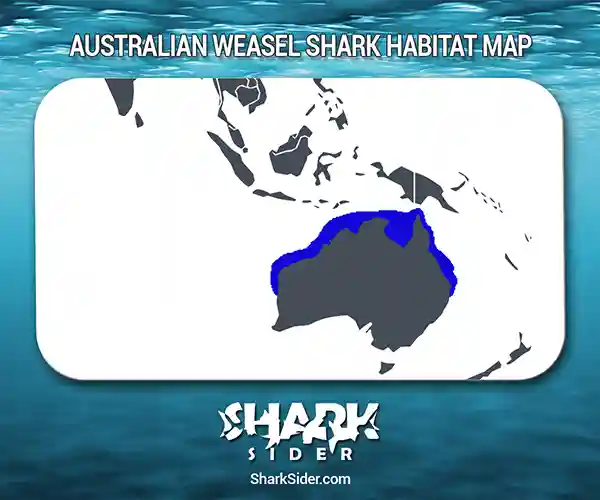The Australian weasel shark is a somewhat rare species of ground shark found off the coasts of northern Australia.
Australian Weasel Shark Scientific Classification |
|
| Kingdom | Animalia |
| Phylum | Chordata |
| Class | Chondrichthyes |
| Order | Carcharhiniformes |
| Family | Hemigaleidae |
| Genus | Hemigaleus |
| Scientific Name | H. australiensis |
Description
These sharks are about 3.6 ft long. It has a slender body with a pointed snout and a crescent-shaped caudal fin on one end. Inside the curved mouth of the shark, there are 28–30 rows of broad, angular teeth in the upper jaw and 46–52 thin and smooth teeth in the lower jaw.
The fins of this shark are all sickle-shaped to an extent. Their eyes are long and oval-shaped, and flaps of sin cover their nostrils.
The shark appears to be bronze or light grey when seen from above. The underside of this shark is much lighter, having an off-white color.
Where do they live
Map Of The Australian Weasel Shark’s Habitat

Australian weasel sharks inhabit a small range along northern Australia, from Geraldton in Western Australia to Brunswick Heads in New South Wales.
The juveniles and young adults live in areas that have seagrass on them, while the more mature adults prefer coral reefs. They tend to swim close to the ocean floor and have been spotted near the surface all the way to depths of 560 ft.
Behavior
Hunting
These sharks specialize in feeding on octopi; to the point where older sharks do not consume anything else. Younger sharks may sometimes feed on bobtail squids and other creatures like crabs, echinoderms, mud lobsters, and other cephalopods.
They generally stalk their prey on the bottom of the sea floor during dusk and dawn but sometimes swim upwards while searching for a meal.
Reproductive
This shark gives live birth to a litter that can have as many as 19 pups, though the average appears to be eight. After gestating for six months, the newborn sharks are about 12 inches long.
Sexual maturity is observed in males at about 24 inches and females at about 26 inches.
Interactions with humans
Despite being commonly caught by fisheries and longlines, the overall population remains stable. This caused the IUCN to classify this shark as “Least Concern” or “LC”.
